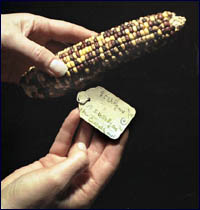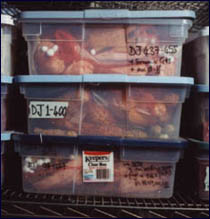

Working with maize at Cold Spring Harbor Laboratory (CSHL) in
the 1940s,
Nobel
laureate Barbara McClintock
did her groundbreaking research
on transposons—transposable genetic elements that are popularly
called "jumping genes." McClintock found that these mobile
pieces of DNA can move from one part of a chromosome to another,
affecting the color of the corn kernels. When she first presented
her work in 1951 at a Cold Spring Harbor meeting, McClintock was
met with stony silence. Today, her research is considered central
to understanding how genes work. You can read more about McClintock
at
http://www.cshl.edu:80/History/mcclintock.html
.
|
|
|
"Cold
Spring Harbor Lab had a longstanding history in plant research, and
obviously, with Barbara McClintock, it has a really strong history
in maize genetics. Cold Spring Harbor has always has had multiple
maize geneticists.
|
|
 "Corn
has been a model organism for many, many years. It was one of the
earlier genetic model systems, and one of the great advantages of
corn was an enormous amount of diversity that had been collected over
multiple years.
"Corn
has been a model organism for many, many years. It was one of the
earlier genetic model systems, and one of the great advantages of
corn was an enormous amount of diversity that had been collected over
multiple years.
|
|
|
|
|

"One of the great things about corn is that after you've done
pollination the ear will grow 3 to 400 kernels, sometimes even more,
and each kernel is the result of a different genetic cross. In the
endosperm, the soft tissue that you eat, a lot of genes are expressed.
Just by looking at a single ear, you can immediately analyze 3 to
400 offspring visually. I think that made it very useful for geneticists
early on."
"The stuff in here is a library, a catalog of all of the current
research that’s been done here. We have some of Dr. McClintock's
corn in here that’s 30 years old. The viability might be reduced,
but it still has a better chance of germinating and growing.
|
|
 "Dr. McClintock could understand things that most people couldn’t
understand. She came up with theories that at the time were not
fully understood by her peers. She knew she was right. She knew
that eventually people would catch up to her and figure out that
she was right. She just took it in stride and continued. Maybe she
turned a little more introverted. But eventually people started
to realize what she was doing was correct, and they started seeking
her out.
"Dr. McClintock could understand things that most people couldn’t
understand. She came up with theories that at the time were not
fully understood by her peers. She knew she was right. She knew
that eventually people would catch up to her and figure out that
she was right. She just took it in stride and continued. Maybe she
turned a little more introverted. But eventually people started
to realize what she was doing was correct, and they started seeking
her out.
"Her work
was not appreciated fully until her career was winding down. If
we had recognized that brilliance early on, maybe more would have
come from her. They caught up with her much later, and she won her
Nobel. Now there are people who come here to do research with corn,
and they’re still doing some of the techniques that she used."
|
|
|
|
|
|
|
|
|